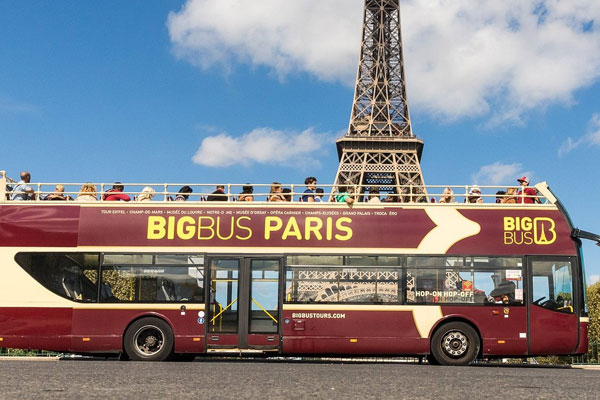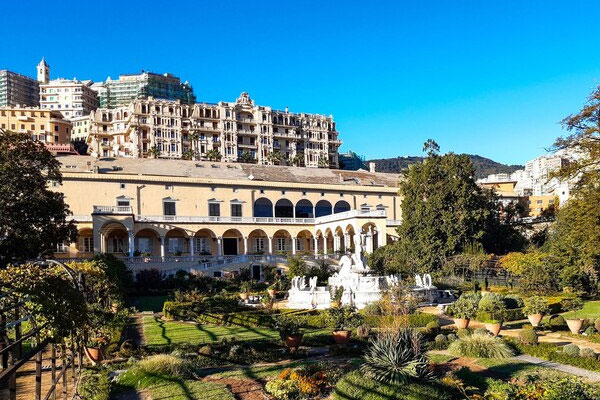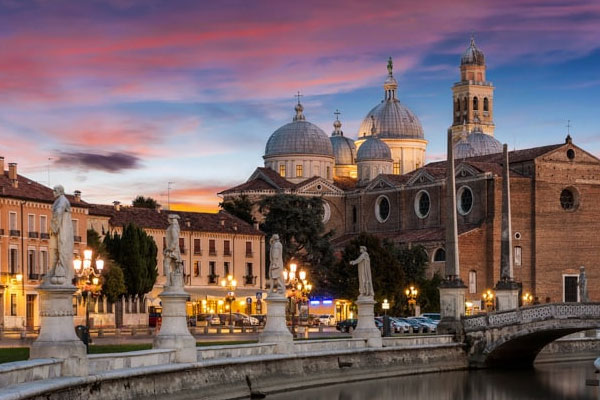Travel
The Eiffel Tower in Paris France

The Eiffel Tower in Paris France
The Eiffel Tower in Paris, France :
Every traveler dreaming of a visit to France invariably aspires to stand beneath the iconic Eiffel Tower in Paris. This is hardly surprising, as the Eiffel Tower not only serves as France’s unmistakable symbol but also stands as one of the world’s most renowned and cherished landmarks.
While debates about the artistic merit of its constructivist style persist, its undeniable allure is most apparent when the evening lights cast a magical glow.
Illumination and Timeless Beauty
Initially, the Eiffel Tower was adorned with ten thousand gas lamps, two searchlights, and a lighthouse on its inauguration day. The nightly spectacle now involves a transition to a warm golden hue at dusk, followed by a breathtaking light show every three minutes, with new multi-colored lights flickering to life.
This enchanting display, accompanied by the constant flashes of cameras from below, bathes the surroundings in an otherworldly glow, creating a sight that is truly unique. This captivating illumination continues until one in the morning throughout the year.
Historical Journey of the Eiffel Tower
The construction of this monumental structure, humorously referred to as the “300-meter tower” by its chief designer Gustave Eiffel, began in mid-September 1884. Initially conceived as the main entrance for the World Exhibition dedicated to the centenary of the French Revolution, no one anticipated the enduring legacy that the Eiffel Tower would carve for itself.
While other pavilions on the Champ de Mars were dismantled at the end of the exhibition, the Eiffel Tower remained standing. Gustave Eiffel himself proclaimed it as the tallest structure ever created by mankind. Over the years, it evolved from a temporary installation into the primary attraction not only in Paris but in all of France.
Architectural Marvels and Technical Wonders
Architect Stéphane Sauvestre injected exquisite artistry into the initially utilitarian three-story design. Stone bases, openwork arched spans, glass pavilions, decorative elements, and a rounded top give the tower a delicate appearance akin to weightless lace when viewed from a distance.
To reach the summit, visitors must ascend three floors either by foot or elevator:
The first floor, shaped like a pyramid, sits at 58 meters.
The second floor, housing an observation deck and a restaurant, perches at 115 meters.
The third floor, elevated to 276 meters, not only features another observation deck but also hosts a lighthouse.
Remarkably, despite its colossal weight of ten thousand tons and a height exceeding three hundred meters, the Eiffel Tower exerts pressure on the ground equivalent to that of a person sitting on a chair.
Construction employed innovative techniques, with tower parts meticulously prepared, numbered, and accompanied by detailed assembly drawings. High-rise construction workers toiled 13 hours a day for twenty-seven months, assembling the puzzle with over 18,000 parts and two and a half million rivets.
Intriguingly, the tower is repainted every seven years by a team of 25 specialists over an 18-month period, consuming 60 tons of paint. Its current bronze color scheme, transitioning from dark at the bottom to a lighter shade on the third level, is aptly named “Eiffel Brown.”
Eiffel Tower Sales Shenanigans
In January 1887, Gustave Eiffel signed a lease for the tower, preventing its dismantling like other exhibition structures. It proved immensely popular, attracting over two million visitors during the exhibition and recouping its construction costs within the first year of operation.
However, not everyone appreciated this marvel of modern architecture. The French intelligentsia called for its immediate demolition, deeming it incompatible with Paris’s exquisite architecture. The installation of radio antennas atop the tower ultimately saved it from being dismantled.
The tower also found itself at the center of notorious scams. In 1925, swindler Victor Lustig capitalized on rumors of the tower’s deteriorating state and successfully sold it for scrap metal. Attempting a similar scheme 25 years later, David Sams managed to sell the tower to the Dutch, resulting in his arrest and financial losses for the duped company.
Culinary Delights at the Eiffel Tower
Dining at one of the Eiffel Tower’s restaurants combines exploration with gastronomy. The 58 Tour Eiffel on the first tier provides a unique experience with its glass floors, roofs, and fences, creating an illusion of limitless space. For a more aristocratic dining experience, “Le Jules Verne,” headed by Michelin-starred chef Alain Ducasse, offers classic French cuisine with exquisite views.
Cafés on the first and second floors cater to those seeking a quick and affordable meal, while the “heavenly” Macaron Bar on the second level tempts those with a sweet tooth. At the tower’s pinnacle (276 meters), Champagne, a bar offering real white or pink champagne, provides the most splendid panoramic view of Paris.
Viewpoints and Excursions
The Eiffel Tower boasts three observation decks:
The first at 57 meters.
The second at 115 meters.
The third at a towering 300 meters, making it the highest observation deck in Paris.
These platforms offer telescopes for a closer look at the city, making them ideal for capturing stunning photos, especially during early morning excursions.
For those planning a visit, numerous excursions cater to different preferences. From bus tours combined with lunch at the Eiffel Tower to Seine River cruises and even dinner at the Eiffel Tower paired with a visit to the iconic Moulin Rouge, options abound.
Accessing the Eiffel Tower
Situated on the Champ de Mars, the Eiffel Tower is easily accessible by metro (6th Hakeim, 7th Trocadero) and various bus routes (42, 72, 69, 87). The tower welcomes visitors nearly year-round, except in cases of severe weather conditions, riots, or excessive crowds.
For those unable to visit Paris or returning tourists, Moscow’s Ostankino TV tower provides a worthy alternative. As the tallest tower in Europe at 540 meters, its upper observation deck at 340 meters offers a breathtaking view of Moscow.
Conclusion
In conclusion, the Eiffel Tower remains a timeless icon that transcends its initial purpose as a temporary structure. It continues to enchant visitors with its architectural brilliance, illuminations, and panoramic views, making it an essential destination for anyone exploring the heart of Paris.
Travel
What to do in Genoa – Travel To Genoa

What to do in Genoa – Travel To Genoa
What to do in Genoa :
Genoa, often overshadowed by its more popular Italian counterparts, holds a wealth of treasures waiting to be discovered. While it may not immediately come to mind when planning an Italian adventure, this maritime city boasts a rich history as the former capital of a powerful republic and the birthplace of renowned figures like Christopher Columbus and Niccolo Paganini.
Despite its lesser-known status, it offers a unique charm and a plethora of attractions that appeal to curious travelers. So, what makes this city special, and what should you do when you visit?
Getting to Genoa
Reaching Genoa is easier than you might think. During the summer months, S7 Airlines offers direct flights, while various European carriers operate year-round flights. Alternatively, you can fly to Milan and take a short train ride to Genoa, which is only about an hour and a half away. Train travel is also an option, with direct routes available from cities like Moscow. Whether you choose to fly or take the train, Genoa is well-connected and easily accessible.
Where to Stay in Genoa
Choosing accommodation in Genoa requires some consideration, especially due to the city’s intricate layout. The historical center may seem compact, but its labyrinthine streets can be confusing to navigate, particularly with luggage. Opting for hotels near major transportation hubs like Principe and Bignoli train stations or metro stations is advisable.
For first-time visitors staying briefly, accommodations near Genova Piazza Principe offer convenience and easy access to transportation links, including the airport bus stop and cruise terminal. From luxurious hotels like the Grand Hotel Savoia to budget-friendly options such as Hotel Chopin, there’s something to suit every preference and budget.
Getting Around Genoa
Exploring Italy on foot is the best way to immerse yourself in its unique atmosphere. While the city’s narrow medieval streets may pose navigational challenges, they offer an authentic glimpse into its history and character. However, public transportation is essential for covering longer distances or navigating the city’s verticality.
Genoa boasts a metro system, buses, funiculars, and elevators integrated into the transportation network. Consider purchasing a 24-hour Genova Pass for unlimited access to public transport, excluding airport shuttles.
What to See in Genoa
Contrary to popular belief, Genoa is brimming with attractions awaiting discovery. From opulent palaces and picturesque gardens to ancient churches and world-class museums, the city offers something for every traveler. Key highlights include Ferrari Square, a grandiose civic space; the Cathedral of St. Lawrence, guarded by stone lions; and the Palazzi dei Rolli, a collection of historic palaces showcasing Genoa’s architectural splendor.
Additionally, numerous churches, including the Church of St. Peter’s and the Church of St. John, offer cultural and architectural delights. Don’t miss iconic landmarks like Villa del Principe, Lanterna lighthouse, and the medieval gate of Porta Soprano, each adding to Genoa’s allure.
Day Trips from Genoa
While Genoa itself warrants exploration, it also serves as an ideal base for day trips to nearby destinations. Along the Ligurian coast, picturesque towns like the Cinque Terre National Park, Portofino, Rapallo, and Camogli beckon with their scenic beauty and charm. Venture westward to discover hidden gems such as Noli, Finale Ligure, and Albenga, each offering its own unique allure.
Beyond the coast, explore the caves of Toirano or visit the historic town of Campo Ligure, known for its medieval castle. With so much to see and do in the surrounding area, Genoa provides an excellent starting point for exploring Liguria’s diverse attractions.
Conclusion
Genoa may not be as widely recognized as other Italian cities, but its cultural heritage, architectural marvels, and coastal beauty make it a destination worth exploring. Whether you’re strolling through its labyrinthine streets, admiring historic palaces, or embarking on day trips along the Ligurian coast, Genoa captivates visitors with its rich history and vibrant atmosphere. So, why not uncover the hidden treasures of this underrated gem on your next Italian adventure?
Travel
Things to do in Rimini Italy

Things to do in Rimini Italy
Do you know the most important Things to do in Rimini Italy? Let’s take a look
Rimini is renowned as a beach resort destination, drawing visitors from Italy and beyond with its long history of seaside hospitality. However, beyond its sandy shores lies a city steeped in ancient heritage and cultural charm, offering a wealth of attractions for travelers to discover. In this comprehensive guide, we’ll delve into everything you need to know to plan an unforgettable trip to Rimini.
Getting to Rimini
Rimini is accessible by air, land, and sea, making it convenient to reach from various parts of Italy and Europe. The city has its own international airport, Federico Fellini Airport, serving both domestic and international flights. Additionally, Rimini is well-connected by train, with direct rail links to major cities like Bologna and Ancona. For those arriving by car, highways provide easy access to Rimini from neighboring regions.
Where to Stay in Rimini
With its status as a popular resort destination, Rimini offers a wide range of accommodation options to suit every traveler’s needs and preferences. The Marina Centro area, situated in the heart of the resort district, is ideal for beachgoers seeking convenience and proximity to amenities.
Here, hotels like Erbavoglio and De Londres offer comfortable accommodations within walking distance of the beach. Alternatively, for those looking to explore the city’s historic center, hotels in the Old Town area provide easy access to landmarks like the Tempio Malatestiano and Ponte di Tiberio.
Getting Around Rimini
Navigating Rimini is relatively straightforward, with most attractions located within easy reach of the city center. Visitors staying in Marina Centro can explore the resort area on foot, while those venturing further afield can make use of public transportation options like buses and trains. Rimini’s efficient public transit system provides convenient access to key sites, including the Old Town and surrounding areas.
What to See in Rimini
Rimini boasts a rich cultural heritage, with a variety of historical and architectural landmarks waiting to be explored. In the city’s historic center, visitors can admire the impressive Tempio Malatestiano, a medieval temple converted into a cathedral, and stroll across the ancient Ponte di Tiberio, a Roman bridge dating back to the 1st century AD. For a glimpse into Italy’s cinematic history, Parco Federico Fellini offers a tribute to the renowned filmmaker with statues and exhibits celebrating his life and work.
In addition to its historical attractions, Rimini is home to modern marvels like Italia in Miniatura, a theme park featuring miniature replicas of famous Italian landmarks. Perfect for families and visitors of all ages, this unique attraction offers a fun and educational experience that showcases the country’s cultural heritage on a smaller scale.
Day Trips from Rimini
While Rimini itself offers plenty to see and do, its strategic location makes it an ideal base for exploring the surrounding region. Nearby destinations like San Marino, Santarcangelo di Romagna, and Gradara are easily accessible by car or public transportation, offering charming villages, historic sites, and picturesque landscapes to discover.
For those seeking a taste of urban culture, cities like Bologna, Ravenna, and Ancona are just a short train ride away, providing opportunities to explore their rich history, vibrant arts scene, and culinary delights.
Conclusion
From its sun-drenched beaches to its ancient landmarks and modern attractions, Rimini offers a diverse array of experiences for travelers to enjoy. Whether you’re soaking up the sun along the Adriatic coast, exploring the city’s historic center, or embarking on day trips to nearby destinations, Rimini promises a memorable and rewarding travel experience for visitors of all interests and ages.
Travel
Where to Stay in Trento Italy

Where to Stay in Trento Italy
Where to Stay in Trento, Italy :
Trento, nestled in a valley at the base of the Alps, is a city worth exploring! With its picturesque surroundings and proximity to other charming towns and attractions, Trento offers something for every traveler. Whether you plan to wander through the city streets, venture into the nearby mountains, or use Trento as a launching pad for further adventures, there’s plenty to see and do here.
Which area of Trento is best for accommodation?
Trento is relatively straightforward to navigate, with the historical city center separated from the train and bus stations by a large square. Near the station, you’ll find a tourist information kiosk where you can pick up a map of the city, or visit a nearby travel agency for assistance.
Trento offers city-wide wireless internet access, although you may need to register in advance for login credentials. It’s worth noting that temperatures can vary significantly between the city and the mountains, so be sure to pack appropriate clothing and footwear for your adventures.
The area around the train station is relatively clean and quiet, making it a convenient option for those planning to explore the region using public transportation. Hotels near the station, such as the Grand Hotel Trento and Hotel America, offer comfortable accommodations at slightly lower prices compared to those in the city center. These hotels provide easy access to both the station and the historical center of Trento, which is just a short walk away.
Speaking of the city center, Trento’s historical district is relatively compact, making it easy to explore on foot. When choosing a hotel in this area, focus on factors such as cost and traveler reviews rather than proximity to specific attractions, as most hotels are within walking distance of the main sights.
Keep in mind that older buildings in the city center may lack amenities like elevators and spacious bathrooms, but they often offer charm and character in abundance.
Hotels such as Hotel Venezia and Hotel Aquila D’Oro offer comfortable accommodations in the heart of Trento’s city center. While some rooms may offer views of the city or nearby landmarks, be prepared for the possibility of street noise, especially in the mornings. Alternatively, Albergo Accademia provides spacious designer rooms with amenities like jacuzzis, although guests may prefer rooms facing the quieter courtyard.
For those seeking a more independent accommodation option, apartments can be a great choice. Borgo Rossi Apartments, located near Piazza Venezia, offer kitchenettes and dining areas, allowing guests to prepare their meals and experience local cuisine firsthand. Be sure to communicate with the apartment owners or managers ahead of time to clarify details like heating and air conditioning availability, parking options, and key pickup procedures.
Conclusion
In conclusion, Trento offers a range of accommodation options to suit every traveler’s needs and preferences. Whether you choose to stay near the train station for convenience or in the heart of the city center for easy access to attractions, you’re sure to enjoy your time exploring this charming Italian city.
-

 Travel9 months ago
Travel9 months agoBest Spinning Rod for Bass 2024
-

 Technology9 months ago
Technology9 months agoBest Lure for Trout 2024
-

 Travel9 months ago
Travel9 months agoBest Hunting and Fishing Clothing 2024
-

 Travel9 months ago
Travel9 months agoBest Robot Vacuum Cleaners 2024
-

 Technology9 months ago
Technology9 months agoBest Floats for Night Fishing
-

 News6 months ago
News6 months agoValentine’s Deals
-

 Technology9 months ago
Technology9 months agoBest Twisters for Fishing 2024
-

 Travel9 months ago
Travel9 months agoBest Spinning Fishing Reels for Bass 2024



















